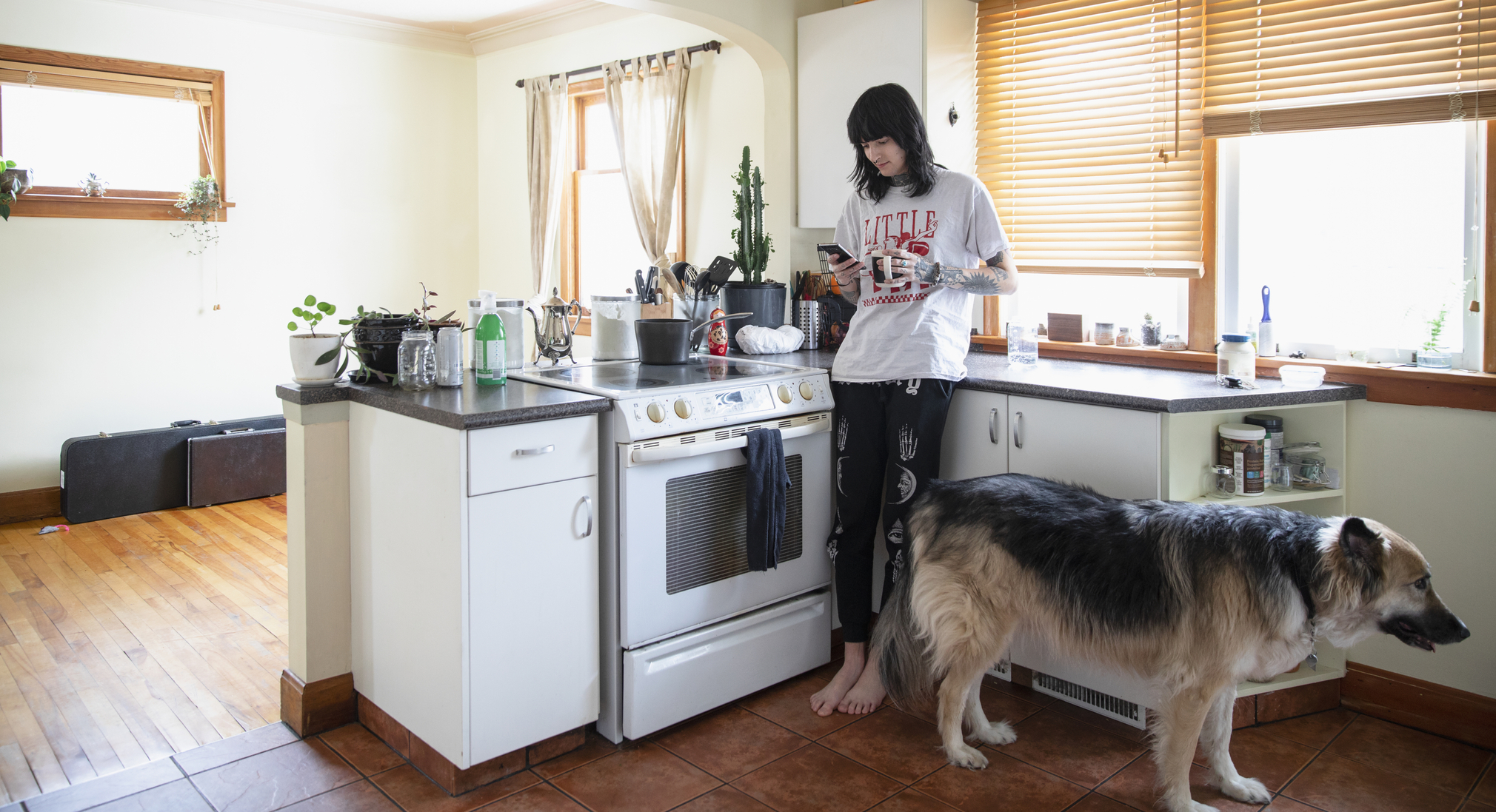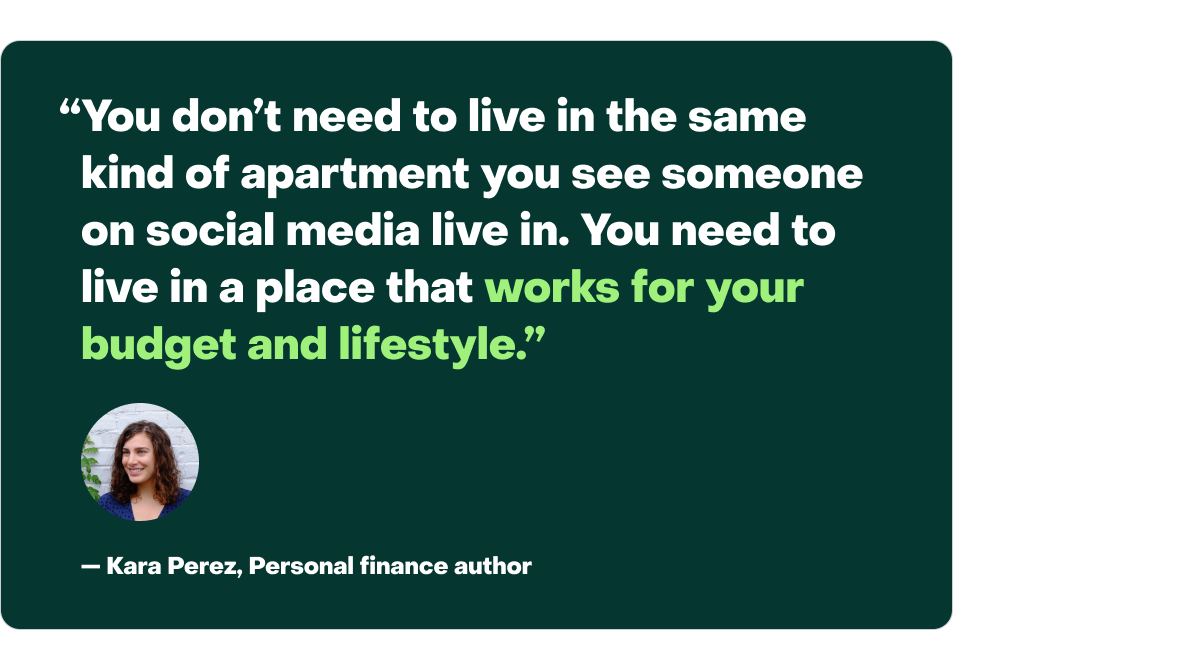How Much Should I Spend on Rent?
Before you look for a place, it's smart — and easy — to figure out how much rent you really can afford.


Written by May Ortega on November 6, 2024
It’s smart to set a realistic expectations about how much you can spend on rent before you start looking at apartments. Doing that first can keep you from falling for the “perfect” place that leaves you cutting things a bit too close every month. But where does one begin? There are guidelines out there that say you should spend 30% of your income on rent. Others say you can spend more than that. But there’s also a way to figure out what works best for you.
We asked Kara Perez, author of financial advice book Green Money, for her best tips on what you need to consider as you begin your search for your next home.
Before you even set your budget, Perez suggests taking a step back and reflecting on what you want versus what you need.
“You don't need to live in the same kind of apartment you see someone on social media live in,” she said. “You need to live in a place that works for your budget and lifestyle.”
Keep that in mind as you find your ideal renting budget.
How much of my income should go to rent?
There are some rules of thumb you could use, like the 30% rule and the 50/30/20 rule. They’re both general guidelines for how to budget for your rent as well as other expenses. But like with many financial situations, there’s not a one-size-fits-all solution.
If you want a quick answer that’s specific to you, Zillow's rent affordability calculator does the heavy lifting for you. Just plug in your monthly after-tax income, living expenses and debts, plus what you save and the city where you want to live. The results include a suggested rent you can comfortably afford as well as listings within that range. You can also explore your other budgeting options below.

Account for hidden expenses
Budgeting advice often focuses on the costs of housing and how much you should save. But don’t forget about the everyday things you spend money on. Does the rent include utilities, or internet? Think about how much you spend on doing laundry, the cost of renter’s insurance, any security deposits, pet costs if you have an animal to feed, to name a few examples. Zillow has some filters to help you out here, like filtering for apartments where utilities are included in the rent, or apartments that come with in-unit laundry.
Is the 30% rule actually helpful?
In today’s housing market, not necessarily.
The 30% rule is a guideline that says 30% of your income should go towards paying your rent or mortgage. So if you make $4,000 a month, your monthly rent should be $1,200 or less.
Perez said this rule is outdated because rent costs have only gotten higher over the last four years.
“[30%] is good to strive for, but in many markets that have experienced multiple years of 10-20% equity gains per year – and thus tax and price increases – it's not possible to stay at 30% or lower,” she said.
Plus, paying 30% may be a misleading figure. Is that income “gross” or “net” (before or after taxes)? And if you have debt like student loans, a car payment, or kids, 30% might be out of the question.
Should I use the 50/30/20 rule?
It depends on where you live and how much you make.
This is a budgeting rule of thumb: 50% of your earnings go toward rent, bills, and needs like food; another 30 can be used for whatever you see fit; and that last 20 goes into your savings. Here’s an example of this guidance, in practice: If you make $4,000 a month, $2,000 of that will go towards your rent and other non-negotiables. You can use another $1,200 for going out to eat, shopping, whatever you like. And you’d keep the other $800 in a savings account. You’d follow these steps every month.
Perez said this rule can apply to some markets, but not all.
“Cost of living has gone up and that means that many people are paying more for food and utilities like car insurance, in addition to higher housing costs,” Perez said. “But rent has actually come down in several major U.S. markets, so some renters are definitely in a good place to make the 50/30/20 rule work!”
She added that she’s not a fan of this specific guidance because it’s too inflexible. You never know when you’ll need to fix your car at the last minute, or pay unexpected medical bills.
How much should I spend on rent?
Perez said there’s not really a rule that applies to every person’s situation. Instead, she suggests setting realistic expectations for yourself, and updating your numbers as your life changes.
She shared her go-to math for budgeting. She said to keep in mind that the three biggest expenses in most people's budgets are housing, food, and transportation.
“So when it comes to figuring out how much rent you can afford, do this math: total income, minus food and transport, minus health insurance and utilities,” she said. “That gives you the number you have left of your bare bones budget.”
Then divide that barebones budget by two, and that will give you an idea of how much you can afford for housing. The other half can go toward anything you may need or want.
Let’s lay out Perez’ math, using the median household income in the U.S. (about $80,600 according to the U.S. Census Bureau), and average spending on other monthly expenses for our example.
If you make $6,717 a month and spend $475 on groceries, $300 on gas and car insurance, $635 on health insurance, and $430 on utilities, you’re left with $3,290. Divide that by two, and you’ll get a range for what you can pay in rent. In this case, that's $1,645. Anything over that might be too financially stressful. The other half is for you to spend however you want.
“I recommend that people do a bi-weekly budget date with themselves and track spending as it happens,” Perez said. “The root of financial literacy is understanding where your money goes every month: bills, fun, savings. You have to be tapped into your own money before you can make any changes to it.”
Rather than trying to stick to a strict number or percentage, she advises you familiarize yourself with your needs and lifestyle, then adjust accordingly.
What if I have debt to pay?
Firstly, Perez gives big congratulations to anyone who’s paying off debts these days.
“It's tough out there and every dollar you pay off is impressive,” she said. “Take advantage of tools like forbearance or deferment if you need to.”
And that’s another factor to include when you do the above-mentioned math. If you have to pay $500 in student loans every month, subtract that from your monthly spending as well. That will make your total left for rent smaller, but it’ll still be a realistic number for you.
How to save money on rent
There are endless ways to cut back on your spending depending on what your money usually goes toward.
Downsize
When thinking about your next rental, don’t look past downsizing or finding a roommate. If it’s just you, or you and a partner, maybe a studio would make more financial sense than a two bedroom. Or choosing an apartment that has less square footage might save you some money too.
Find a roommate
Perhaps you can live with someone else while you save up. Here's a guide on how you can find the right roommate so you can feel more confident during your hunt. Maybe you can move in with family for a while, if that makes you more comfortable.
“A year living with roommates doesn't mean the rest of your life you'll be living with roommates,” Perez said. “Use short-term saving sprints to boost your overall financial health.”
You can look for individual rooms to rent on Zillow instead of a whole house, so you can explore how that could fit into your budget. We’ve got some tips on what questions to ask any potential roommates before you commit.
Consider if you qualify for income-restricted housing
Maybe you’re trying to set a budget because your housing market is simply too high for what you earn. Zillow offers a filter for income-restricted rentals. These homes have income caps that determine eligibility. Most of them lay out what criteria you need to meet to qualify.
Choose a short-term lease
Speaking of short-term savings, Zillow has a filter for rentals with shorter leases. That way you can save up for three or six months, allowing you to afford something else later.
Find a furnished apartment
This can save you some big money if you’re in need of a bed or a sofa. You can choose to filter for rentals that come furnished when you search on Zillow. There are way more options than you might think.
Adjust the rest of your spending
If you drive a lot for work or for fun, filling up your tank all the time can add up. You could look for a rental closer to your job so you don’t have to drive as far. Hosting the fun at your place could save you on gas, too.
Negotiate with your landlord
If you’re already in a rental that’s stretching your budget thin, Perez suggests negotiating with your landlord.
“Can you do the yard work in exchange for a 15% rent discount? Do they have multiple properties that need marketing work you can provide?” she asked. “Always, always negotiate! I once got $50 a month off rent because the floors were uneven.”
You can also try to negotiate before you move in. But don’t rely on any discounts. You should still choose a place that’s within your budget. If your negotiations do work out, that’s more money you have for other things.
Find an apartment you’ll love on Zillow
With Zillions of up-to-date listings and filters for your must-haves, it's easy to find your perfect apartment on Zillow Rentals.
Search rentals


